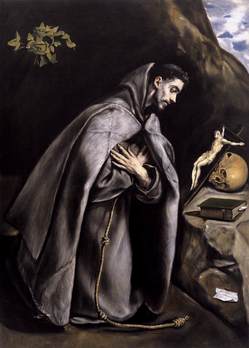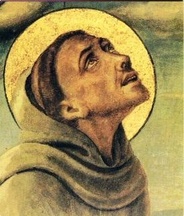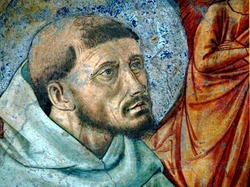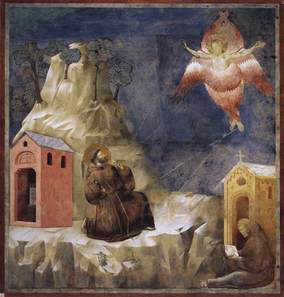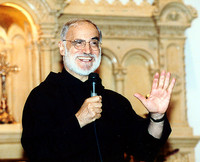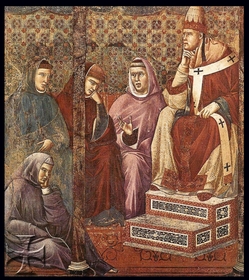
On Saturday, April 18, the Holy Father received various members of the Franciscan family at Castel Gandolfo to observe the 800th anniversary of the ecclesial recognition of the Charism of Saint Francis of Assisi. His remarkable talk is presented here with my emphases. As always the Pope gently and clearly speaks a word of truth and hope.
With great joy I welcome you all at this happy and historic occasion that has gathered you all together: the eighth centenary of the approval of the “protoregola” [monastic rule] of St. Francis by Pope Innocent III. Eight hundred years have passed, and those dozen friars have become a multitude, scattered all over the world and now here, by you, worthily represented. In recent days you have gathered in Assisi for what you wanted to call the “Chapter of Mats” to recall your origins. And at the end of this extraordinary experience you have come together with the “Signor Papa” [Lord Pope], as your seraphic founder would say. I greet you all with affection: the Friars Minor of the three branches, guided by the respective Ministers General, among whom I thank Father José Rodriguez Carballo for his kind words, the members of the Third Order, with their Minister General; the Franciscan women religious and members of the Franciscan secular institutes, and knowing them spiritually present, the Poor Clares, which constitute the “second order.”
I am pleased to welcome some Franciscan bishops, and in particular I greet the bishop of Assisi, Archbishop Domenico Sorrentino, who represents the Church of Assisi, the home of Francis and Clare, and spiritually, of all the Franciscans. We know how important it was for Francis, the link with the bishop of Assisi at the time, Guido, who acknowledged his charisma and supported it. It was Guido who presented Francis to Cardinal Giovanni of St. Paul, who then introduced him to the Pope and encouraged the adoption of the Rule. Charism and institution are always complementary for the edification of the Church.
What should I tell you, dear friends? First of all I would like to join you in giving thanks to God for the path that he has marked out for you, filling you with his benefits. And as Pastor of the Church, I want to thank him for the precious gift that you are for the entire Christian people. From the small stream that flowed from the foot of Mount Subasio, it has formed a great river, which has made a significant contribution to the universal spread of the Gospel. It
all began from the conversion of Francis, who, following the example of Jesus “emptied himself” (cf. Phil 2:7) and, by marrying Lady Poverty, became a witness and herald of the Father who is in heaven. To the “Poverello” [little poor man], one can apply literally some expressions that the apostle Paul uses to refer to himself and which I like to remember in this Pauline Year: “I have been crucified with Christ and it is no longer I who live, but Christ who lives in me. And this life, I live in the flesh, I live by faith of the Son of God who has loved me and given himself for me” (Gal. 2:19-20). And again: “From now on let no one bother me: for I wear the marks of Jesus on my body” (Gal 6:17).
 Francis reflects perfectly the footsteps of Paul and in truth can say with him: “For me, to live is Christ” (Phil 1:21). He has experienced the power of divine grace and he is as one who has died and risen. All his previous wealth, any source of pride and security, everything becomes a “loss” from the moment of encounter with the crucified and risen Jesus (cf. Phil 3:7-11). The leaving of everything at that point becomes almost necessary to express the abundance of the gift received. A gift so great as to require a total detachment, which itself isn’t enough; it requires a entire life lived “according to the form of the holy Gospel” (2 Tests, 14: the Franciscan Sources, 116).
Francis reflects perfectly the footsteps of Paul and in truth can say with him: “For me, to live is Christ” (Phil 1:21). He has experienced the power of divine grace and he is as one who has died and risen. All his previous wealth, any source of pride and security, everything becomes a “loss” from the moment of encounter with the crucified and risen Jesus (cf. Phil 3:7-11). The leaving of everything at that point becomes almost necessary to express the abundance of the gift received. A gift so great as to require a total detachment, which itself isn’t enough; it requires a entire life lived “according to the form of the holy Gospel” (2 Tests, 14: the Franciscan Sources, 116).
And here we come to the point that surely lies at the heart of our meeting. I would summarize it as follows: the Gospel as a rule of life. “The Rule and life of the Friars Minor is this, to observe the Holy Gospel of our Lord Jesus Christ:” this is what Francis writes at the beginning of his Rule (Rb I, 1: FF, 75). He defined himself entirely in the light of the Gospel. This is his charm. This is his enduring relevance. Thomas of Celano relates that the Poverello “always held himself in the heart of Jesus. Jesus on the lips, Jesus in his ears, Jesus is his eyes, Jesus in his hands, Jesus in all the other members […] In fact finding himself often traveling and meditating or singing about Jesus, he would forget he was traveling and would stop to invite all creatures to praise Jesus” (1 Cel., II, 9, 115: FF115). So the Poverello has become a living gospel, able to attract to Christ men and women of all ages, especially young people, who prefer radical idealism to half-measures. The Bishop of Assisi, Guido, and then Pope Innocent III recognized in the proposal of Francis and his companions the authenticity of the Gospel, and knew how to encourage their commitment for the good of the Church.
Here is a spontaneous reflection: Francis could have also not gone to the Pope. Many religious groups and movements were forming during that time, and some of them were opposed to the Church as an institution, or at least didn’t seek the Churches’ approval. Certainly a polemical attitude towards the hierarchy would have won Francis many followers. Instead, he immediately thought to put his journey and that of his companions into the hands of the Bishop of Rome, the Successor of Peter. This fact reveals his true ecclesial spirit. The little “we” that had started with his first friars he conceived from the outset inside
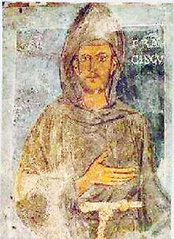 the context of the great “we” of the one and universal Church. And the Pope recognized and appreciated this. The Pope, in fact, on his part, could have not approved the project of the life of Francis. Indeed, we can well imagine that among the collaborators of Innocent III, some counseled him to that effect, perhaps fearing that his group of monks would end up resembling other heretical groups and pauperisms of the time. Instead the Roman Pontiff, well informed by the Bishop of Assisi and Cardinal Giovanni of St. Paul, was able to discern the initiative of the Holy Spirit and welcomed, blessed and encouraged the nascent community of “Friars Minor.”
the context of the great “we” of the one and universal Church. And the Pope recognized and appreciated this. The Pope, in fact, on his part, could have not approved the project of the life of Francis. Indeed, we can well imagine that among the collaborators of Innocent III, some counseled him to that effect, perhaps fearing that his group of monks would end up resembling other heretical groups and pauperisms of the time. Instead the Roman Pontiff, well informed by the Bishop of Assisi and Cardinal Giovanni of St. Paul, was able to discern the initiative of the Holy Spirit and welcomed, blessed and encouraged the nascent community of “Friars Minor.”
Dear brothers and sisters, eight centuries have passed, and now you have wanted to renew this gesture of your founder. You are all sons and heirs of those origins, of that “good seed” which was Francis, who was conformed to the “grain of wheat” which is the Lord Jesus, died and risen to bring forth much fruit (cf. Jn 12:24). The saints propose anew the fruitfulness of Christ. As Francis and Clare of Assisi, you also commit yourselves to follow the same
 logic: to lose your lives for Jesus and the Gospel, to save them and make them abundantly fruitful. While you praise and thank the Lord who has called you to be part of such a great and beautiful family, stay attentive to what the Spirit says to it today, in each of its components, to continue to proclaim with passion the Kingdom of God, the footsteps of your seraphic father. Every brother and every sister should keep always a contemplative mood, happy and simple; always begin from Christ, as Francis set out from the gaze of the Crucifix of San Damiano and from the meeting with the leper, to see the face of Christ in our brothers and sisters who suffer and bring to all his peace. Be witnesses to the “beauty” of God, which Francis was able to sing contemplating the wonders of creation, and that made him exclaim to the Most High: “You are beauty!” (Praises of God Most High, 4.6: FF 261).
logic: to lose your lives for Jesus and the Gospel, to save them and make them abundantly fruitful. While you praise and thank the Lord who has called you to be part of such a great and beautiful family, stay attentive to what the Spirit says to it today, in each of its components, to continue to proclaim with passion the Kingdom of God, the footsteps of your seraphic father. Every brother and every sister should keep always a contemplative mood, happy and simple; always begin from Christ, as Francis set out from the gaze of the Crucifix of San Damiano and from the meeting with the leper, to see the face of Christ in our brothers and sisters who suffer and bring to all his peace. Be witnesses to the “beauty” of God, which Francis was able to sing contemplating the wonders of creation, and that made him exclaim to the Most High: “You are beauty!” (Praises of God Most High, 4.6: FF 261).
Dear friends, the last word I would like to leave with you is the same that the risen Jesus gave to his disciples: “Go!” (cf. Mt 28:19, Mk 16:15). Go and continue to “repair the house” of the Lord Jesus Christ, his Church. In recent days, the earthquake that struck the Abruzzo region has severely damaged many churches, and you from Assisi know what this means. But there is another “ruin” that is far more serious: that of people and communities! Like Francis, always start with yourselves. We are the first house that God wants to restore. If you are always able to renew yourselves in the spirit of the Gospel, you will continue to assist the pastors of the Church to make more and more beautiful the Church’s face, that of the bride of Christ. The Pope, now the same as then, expects this of you. Thank you for coming! Now go and bring to all the peace and love of Christ the Savior. May Mary Immaculate, “Virgin made Church” (cf. Greetings to the Blessed Virgin Mary, 1 FF, 259), accompany you always. And may my Apostolic Blessing, which I cordially impart to all of you here present, and the entire Franciscan family, support you as well.
Benedictus PP. XVI
See the video clip on the Pope-Franciscan visit
 Saint Francis seems to be a model of holiness for many, many people. Protestants of all flavors, the Muslims and Jews honor dear Francis for a variety of reasons. They’ve met Francis in as many ways as I have.
Saint Francis seems to be a model of holiness for many, many people. Protestants of all flavors, the Muslims and Jews honor dear Francis for a variety of reasons. They’ve met Francis in as many ways as I have.


